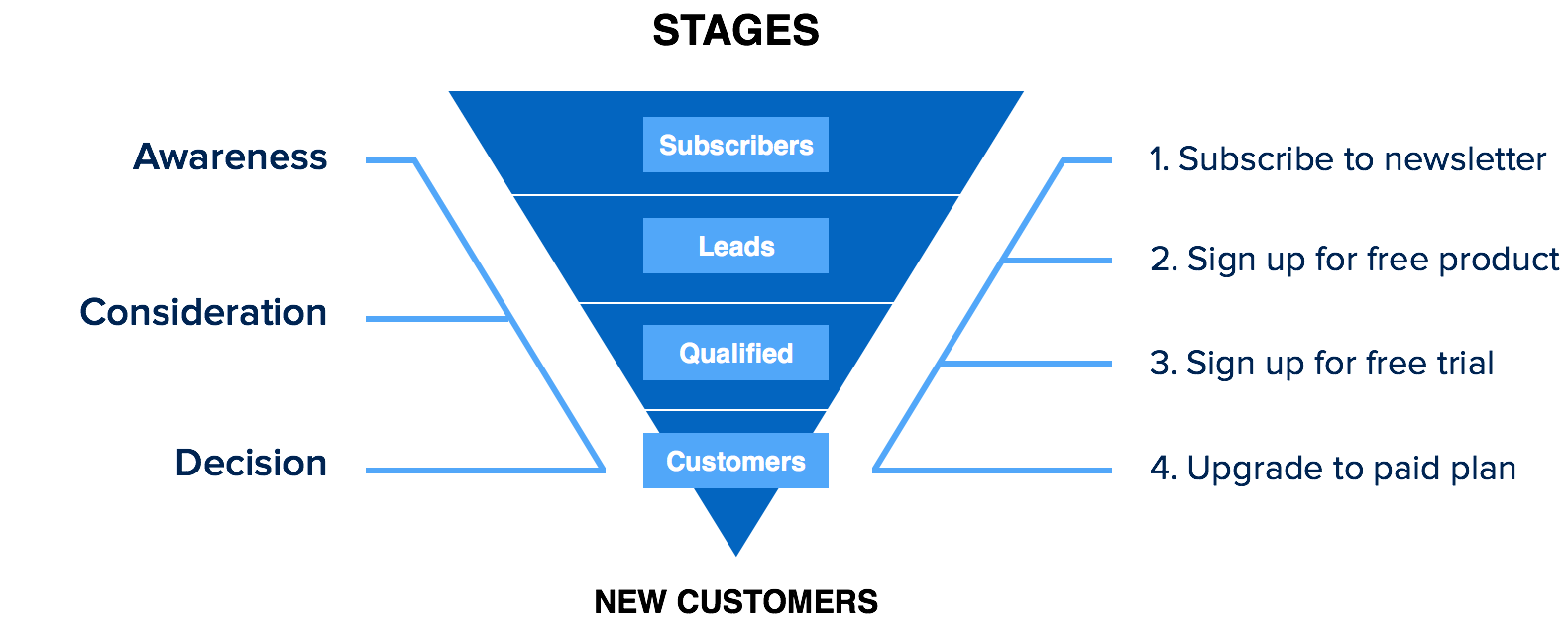On-site retargeting and marketing automation go hand and hand. If you use automated email campaigns in your marketing, then you can imagine on-site retargeting like marketing automation, but on your website. Instead of automating email campaigns, you're automating calls-to-action that convert visitors into leads and move them down your funnel.
Using both marketing automation and on-site retargeting together, allows you to engage your prospects with the right message both on your website and in their inbox.
In this chapter, we'll show you how to automate your customer acquisition funnel using these two marketing strategies in your business.
1. Identify the stages in the conversion funnel

One reason many growing businesses that are trying to systematize their marketing and sales process struggle to acquire customers, is because they have not clearly defined the different stages of their conversion funnel.
By doing this, you can define one or more paths to convert their visitors into customers.
Furthermore, your marketing and sales efforts become more effective due to the fact that you are targeting people at each stage with a personalized call-to-action designed to move them to the next step.
It also becomes easier to track specific metrics that help you optimize your customer acquisition process.
For example:
You’re able to track conversion rates from one stage to the other, like your visitor-to-subscriber conversion rate, and subscriber-to-lead conversion rate, and so on.
You’ll also be able to more accurately track the length of the sales cycle for your customers, giving you a better idea how long it takes for a person to convert based on the stage they’re in.
2. Identify your conversion goals

Once you’ve defined your conversion funnel stages, you can set conversion goals, and optimize marketing campaigns to get visitors to complete those goals.
For this example we have:
- Subscribe to newsletter
- Sign up for free product
- Sign up for full trial
- Upgrade to paid plan
3. Promote those goals with personalized calls-to-action

You should promote these goals on your site using calls-to-action that are personalized for visitors based on the exact stage they’re at in your conversion funnel.
These calls-to-action could proactively engage your visitors like in some of the examples we showed you earlier. Or they could be part of the inline content of your website. The idea is that you want to make these CTAs dynamic, and show visitors the right ones based on which step they need to take next.
4. Trigger marketing actions that move leads down the funnel

When visitors engage with your calls-to-action and complete your conversion goals, you’ll want to trigger the right marketing actions, and follow up with leads using the right channels.
Some examples would be email follow-up campaigns, retargeting ad campaigns on Google and Facebook, or whichever channels you use in your particular business.
The great thing is that there are tools like ConvertFlow that make it easy to engage the person on the right channel, and keep all your marketing channels in sync.
Now, your funnel proactively drives visitors to become customers

Once you’ve identified the stages and conversion goals in your marketing funnel, and you’re proactively driving visitors to become customers through a clear path using email follow-up campaigns, as well as deploying both onsite and offsite retargeting, you’ll be at a great point where you’ll be able to start making your customer acquisition work for you.
However, you still may lose potential customers, because you’re forcing everyone through the same funnel, even though each visitor may enter your funnel at different stages, and may have different reasons for buying.
5. Convert more customers with personalized conversion flows

This is where creating personalized conversion flows for each visitor comes into play.
Conversion flows are the paths visitors follow on your website to become customers or to achieve the goal for a marketing campaign. A conversion flow is something you should design as if you were creating any sort of marketing automation campaign.
The flow helps you identify conversion goals that are targeted to a specific segment of visitors who meet certain criteria.
For example, let’s say we run a marketing agency, and our main goal is acquire more clients.
Our agency offers 3 services; Google Adwords management, a Facebook ads service, and a content marketing service.
And let's say we offer 3 different lead magnets on our site, one for each service. The people who download our lead magnet for our Facebook ads service will get added to a conversion flow for Facebook ads, and now all the calls-to-action they’re retargeted with, the ads they see online, and the follow-up emails they receive will be designed to move them through the conversion funnel until they become clients for our Facebook ads service.
There’s no point in forcing people to see marketing about our other services, because they’ve expressed interest in our Facebook ads service. We could do the same for other leads that showed interest in other services.
This allows us to create high-converting marketing campaigns that drive leads through our funnel, because they are relevant to what the lead is most interested in.









.svg)
